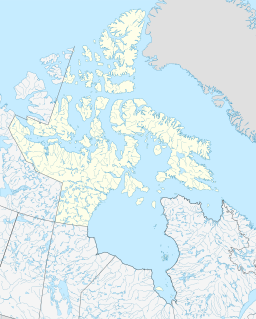Kangiqtualuk Uqquqti
| Kangiqtualuk Uqquqti | |
|---|---|
 Kangiqtualuk Uqquqti Location in Nunavut | |
| Location | Baffin Island, Nunavut |
| Coordinates | 70°43′51″N 070°43′53″W / 70.73083°N 70.73139°WCoordinates: 70°43′51″N 070°43′53″W / 70.73083°N 70.73139°W |
| Type | Fjord |
| Ocean/sea sources | Baffin Bay |
| Basin countries | Canada |
| Max. length | 110 km (68 mi) |
| Max. width | 19 km (12 mi) |
Kangiqtualuk Uqquqti (Inuktitut syllabics: ᑲᖏᖅᑐᐊᓗᒃ ᐅᖅᑯᖅᑎ[1]) formerly Sam Ford Fiord[2] is an isolated, elongated Arctic fjord on Baffin Island's northeastern coast in the Qikiqtaaluk Region of Nunavut, Canada.[3] The Inuit settlement of Pond Inlet is 320 km (200 mi) to the northwest and Clyde River is 80 km (50 mi) to the east.
This fjord is reputed for the harsh beauty of its landscapes with rocky cliffs rising steeply from the shore.[4] It is also a popular place with climbers.[5]
History[]
Kangiqtualuk Uqquqti had been one of the traditional hunting areas of the Inuit.[6] It was renamed in memory of Inuk linguist Sam Ford, who died in a helicopter crash[7] but it has since reverted to its original name.
Geography[]

Kangiqtualuk Uqquqti stretches roughly from north northeast to south southwest for about 110 km (68 mi). Its mouth, located between the Remote Peninsula and , is over 18 km (11 mi) wide, the width of the fjord narrowing gradually to an average of 3 km (1.9 mi) about 50 km (31 mi) inland. Kangiqtualuk Agguqti is a tributary fjord branching west from the fjord's western shore about 45 km (28 mi) to the south of its mouth. The —with stretches northwards from Walker Arm's northwest corner and connects with the neighbouring . is a smaller inlet on the eastern shore of Sam Ford Fiord connecting through Ottawa Creek and Atagulisaktalik with the inner reaches of neighbouring Arviqtujuq Kangiqtua in the east.[8] The discharges its waters at the head of the fjord further south[9] and is located within the inner section of the fjord off a small bay 15 km (9.3 mi) to the north northeast of the river's mouth.[8]
Sam Ford Fiord is known for its glaciers and its awe-inspiring stark granite cliffs, rising steeply from its shores to heights up to 1,500 m (4,900 ft) above sea level in the area near Swiss Bay. Among the most impressive summits by the fjord ,[10] ,[11] , , , , , and the deserve mention.[8]
A massive cliff on the eastern shore located at a bend in the fjord 49 km (30 mi) from its mouth at 70°37′51.82″N 70°55′0.33″W / 70.6310611°N 70.9167583°W has a vertical wall dropping from a height of 1,368 m (4,488 ft) to the fjord's waters.[12]
See also[]
References[]
- ^ "Kangiqtualuk Uqquqti". Geographical Names Data Base. Natural Resources Canada. Retrieved 2020-06-15.
- ^ "Kangiqtualuk Uqquqti (Formerly Sam Ford Fiord)". Geographical Names Data Base. Natural Resources Canada. Retrieved 2020-06-15.
- ^ "Water Features - Nunavut". The Atlas of Canada. Retrieved 2008-11-11.
- ^ 4. Bericht von Bord: Die spektakulären Fjorde Kanadas (German)
- ^ Greenland 2014: Baffin Island and Sam Ford Fjord for Favresse, Ditto and Villanueva
- ^ Qikiqtani Truth Commission: Community Histories 1950–1975
- ^ Sam Ford Fiord – Kangiqtualuk Uqquqti
- ^ a b c "Sam Ford Fiord". Mapcarta. Retrieved 25 April 2016.
- ^ NRC Sam Ford River
- ^ "Beluga Mountain". Around Guides. Retrieved 25 April 2016.
- ^ North America, Canada, Canadian Arctic, Beluga Mountain and Rock Tower, Sam Ford Fiord, Baffin Island, 1987 - AAJ Climbs And Expeditions, Volume 31, Issue 63 (1989) p. 163
- ^ GoogleEarth
External links[]
- The massive rock walls of Sam Ford Fiord
- Steep cliff at the southern entrance of Sam Ford Fjord
- Sam Ford Fjord landscapes
- Sam Ford Fjord - out of this world
- Walrus Head; Time for a Rest
- To the Ends of the Earth - BASE Jumping Baffin Island
- Ted Davenport's Ski-BASE expedition
- Канада Баффинова Земля 2007 (Russian)
- Bodies of water of Baffin Island
- Fjords of Qikiqtaaluk Region
